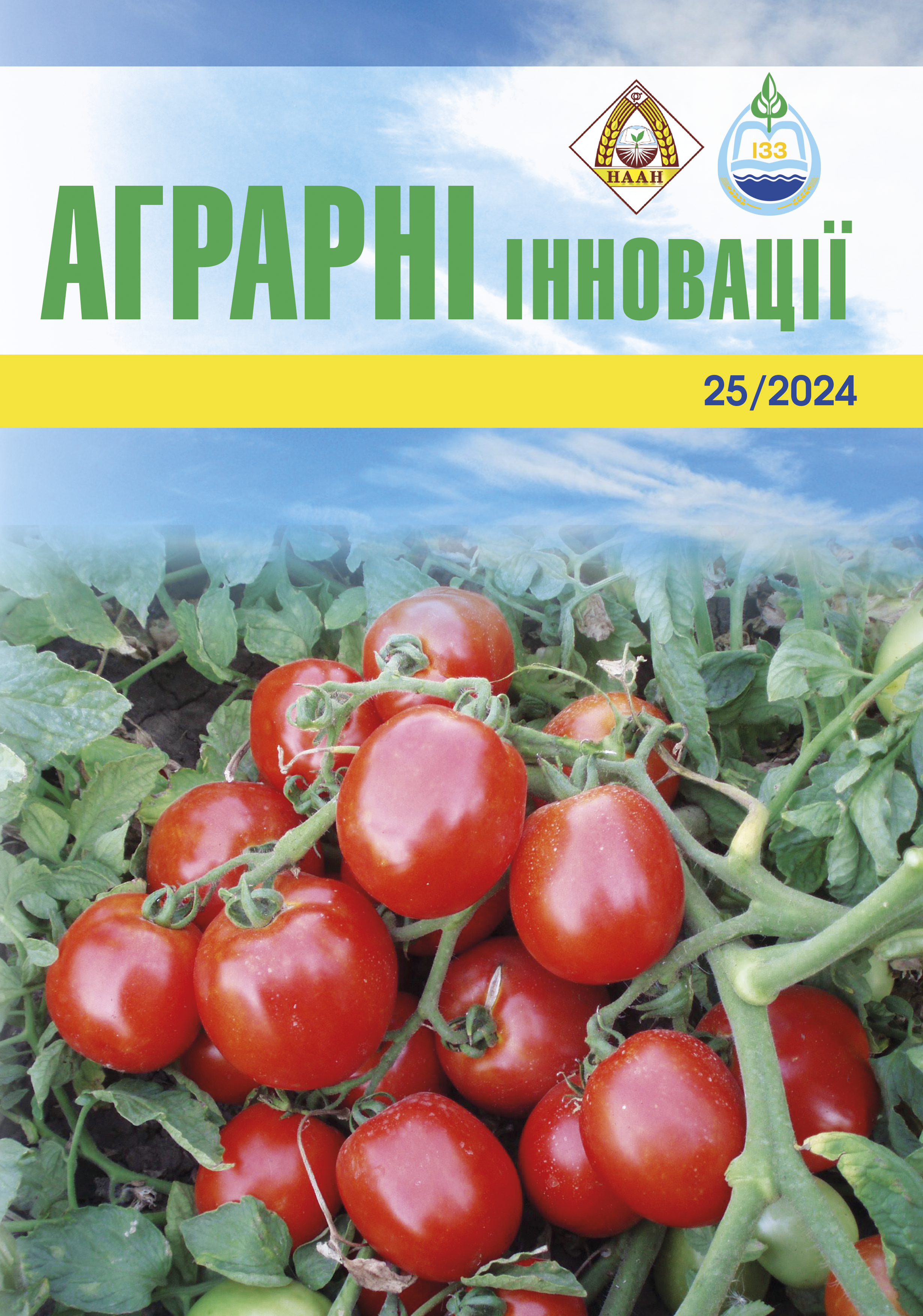System of agrotechnical protection of pea agrocenoses from weeds
Abstract
Goal. To develop and scientifically substantiate ways of increasing the productivity of peas, which involve the optimization of agrotechnical measures to protect its crops from weeds. Methods. The research was conducted during 2022–2023 in the conditions of the experimental field of VNAU in the village of Agronomichne. In the process of carrying out the research, a combination of general scientific methods was used: hypothesis, observation, analysis; and special: laboratory and field. Experimental indicators were processed by methods of mathematical statistics. Research results. The number of weeds in the control plots of peas sown in the phase of the 2nd leaf was 35 weeds/m2. In the phase of 7 pea leaves, the number of weeds on the specified option increased by 1.8 timesand amounted to 64 pcs./m2. At the end of the vegetation period, due to the end of the vegetation period, their number decreased by 1.4 times and amounted to 47 pcs./m2. Carrying out early spring soil cultivation with a cultivator to a depth of 5–8 cm, rolling with ring-spur rollers after sowing peas, and then pre-emergence harrowing with light harrows of the pea agrocenosis on the 5th day after sowing helped to reduce the number of weeds in the phase of the 2nd leaf of peas in 1.9 times than in the version without pre-emergence harrowing and amounted to 18 pcs./m2. In the phase of 7 pea leaves, weediness increased by 1.6 times in the specified option and amounted to 28 weeds/m2. Early spring cultivation of the soil with a cultivator with flat-cutting working bodies to a depth of 5–8 cm, rolling with ringspur rollers after sowing peas ensures a seed yield of 1.43 t/ha. Conclusions. Agrotechnical measures of pre-sowing cultivation and seed rolling are generally accepted and mandatory when growing peas. Early spring cultivation of the soil with a cultivator with flat-cutting working organs to a depth of 5–8 cm, rolling with ring-spur rollers after sowing peas, as well as pre-emergence and post-emergence harrowing of pea sowing with light harrows ensures an increase in the yield of peas compared to the control by 72.0% to the level 2.46 t/ha.
References
2. Коблай С. В., Рабічук А. В., Мурсокаєв Е. В. Нові сорти гороху (Рisum sativum L.) Одеської селекції. 100-річчя формування національних сортових рос-
линних ресурсів України : матеріали Міжнар. наук.-пр-акт. конф. 29 верес. 2023 р., м. Київ : Мінагроп.
Український інститут експертизи сортів рослин. 2023. С. 48–49.
3. Колесніков М., Пащенко Ю. Формування бобово-ризобіального симбіозу гороху посівного за дії комплексних регуляторів росту в умовах Південного
Степу України. Кліматичні зміни та сільське госпдарство. Виклики для аграрної науки та освіти : зб.
матеріали VІ Міжнар. наук.-практ. конф. 15 берез. 2023 р. Київ. Науково-методичний центр ВФПО.
2023. С. 28–31.
4. Урожай бобових в Україні у 2023 році аналітики оцінюють на рівні 390 тис. веб-сайт. URL : https://superagronom.com/news/17437-urojay-bobovih-vukra
yiniu-2023-rotsiana-litiki-otsinyuyut-na-rivni-390-tis-t (дата звернення 30.05.2024).
5. Січкар В. І. Роль зернобобових культур у вирішенні білкової проблеми в Україні. Корми і кормовиробництво. 2004. Вип. 53. С. 110–115.
6. Лихочвор В. В., Андрушко М. О. Продуктивність гороху залежно від сорту та норм висіву. Вісник аграної науки Причорномор’я. 2020. Вип. 2. С. 54–62.
7. Жуйков О. Г., Лагутенко К. В. Горох посівний в Україні – стан, проблеми, перспективи. Таврійський
науковий вісник: землеробство, рослинництво, овочівництво та баштанництво. Херсон, 2017. № 98.
С. 65–70.
8. Крижанівський В. Г. Економічна та енергетична ефективність вирощування гороху, пшениці озимої та буряку цукрового за різних заходів основного обробітку ґрунту. Агробіологія. 2015. № 1. С. 27–30.
9. Руденко В. А. Порівняльна продуктивність зимуючих і ярих сортотипів гороху залежно від норми висівуу Південному Степу України : дис. … наук. ст. д-ра
філос. : 201 – Агрономія, Одеський держ. аграр. ун-т, 2023. 195 с.
10. Манько Ю. П. Потенційна забур’яненість поля. Захист рослин. 2000. № 4. C. 6.
11. Танчик С. П. Проти однорічних та багаторічних двсім’ядольних. Захист рослин. 1999. № 6. C. 10–11.
12. Мойсейченко В. Ф., Єщенкою В. О. Основи наукових досліджень в агрономії. К.: Вища школа. 1994. 334 с.






